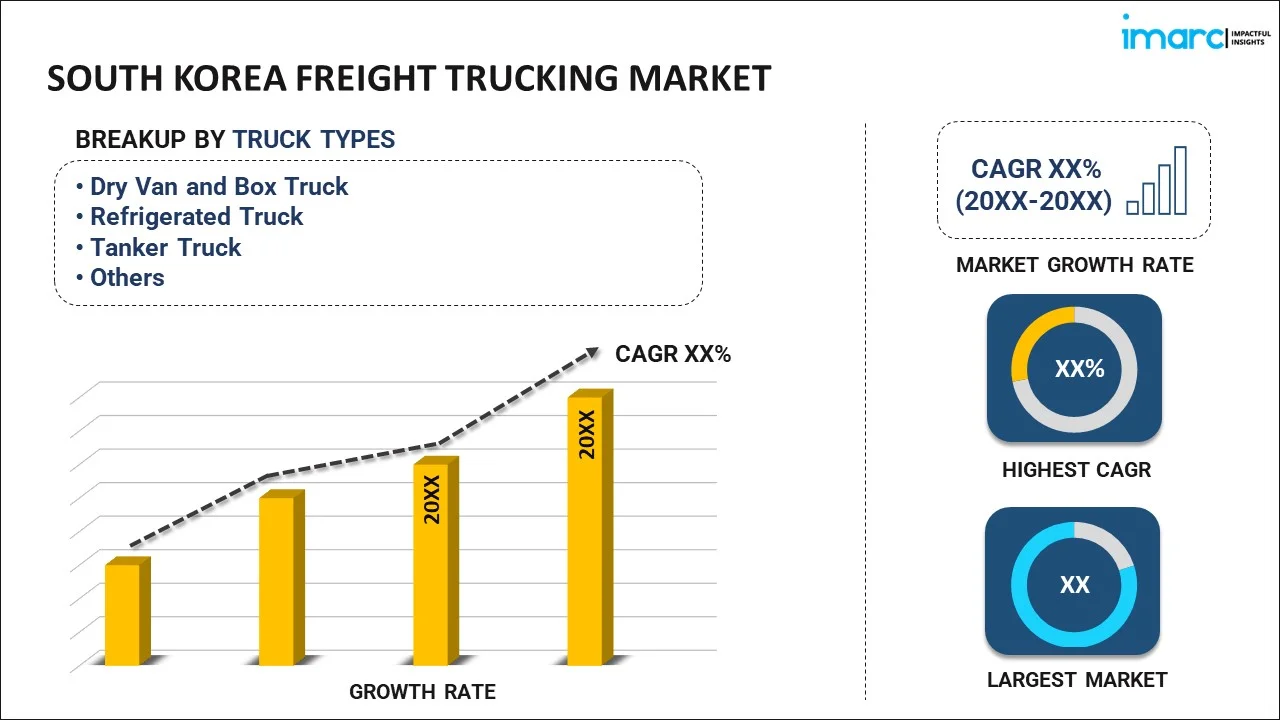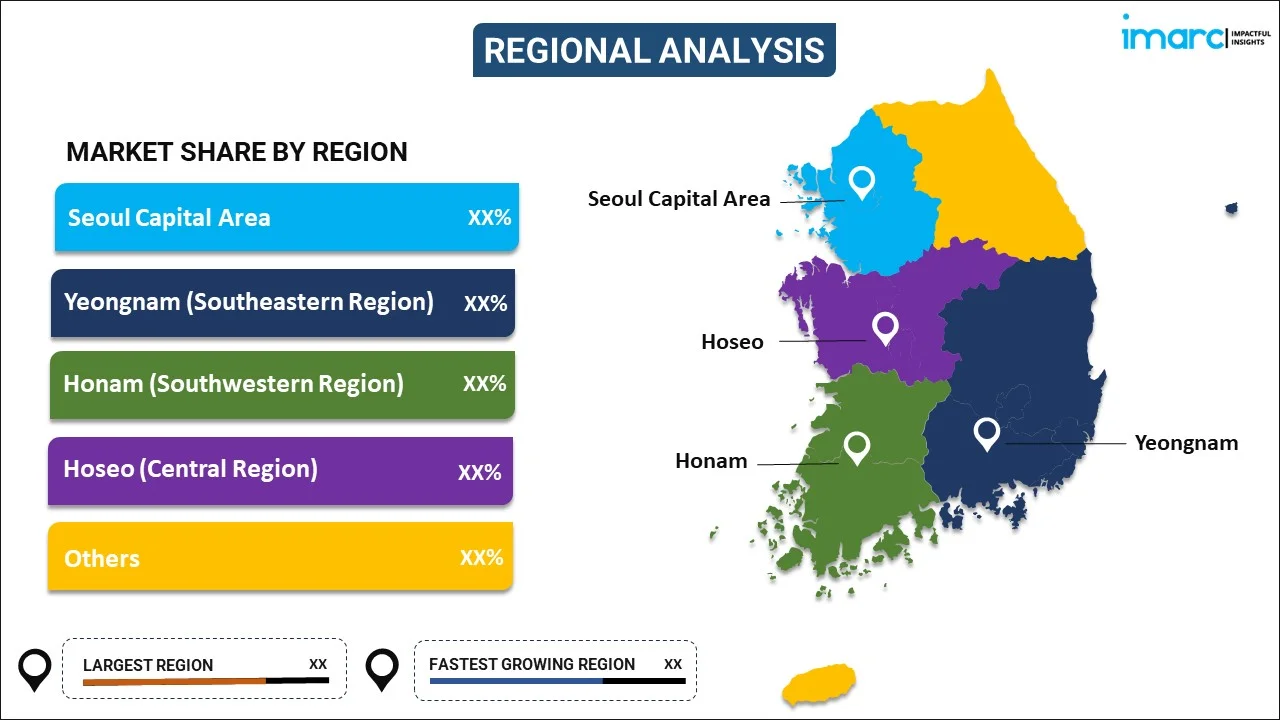
South Korea Freight Trucking Market Report by Truck Type (Dry Van and Box Truck, Refrigerated Truck, Tanker Truck, Flatbed Truck, and Others), Cargo Type (Dry Bulk Goods, Oil and Diesel, Postal, and Others), Distance (50 Miles or Less, 51 to 100 Miles, 101-200 Miles, 201-500 Miles, Above 500 Miles), End User (Food and Beverages, Industrial and Manufacturing, Energy and Mining, Oil and Gas, Pharmaceutical and Healthcare, and Others), and Region 2024-2032
Market Overview:
South Korea freight trucking market size is projected to exhibit a growth rate (CAGR) of 5.50% during 2024-2032. The growing need in the textile and apparel industry, rising reliance on advanced technologies like global positioning system (GPS) tracking, telematics, and fleet management systems, and increasing utilization in waste collection and disposal services represent some of the key factors driving the market.
|
Report Attribute
|
Key Statistics
|
|---|---|
|
Base Year
|
2023 |
|
Forecast Years
|
2024-2032 |
|
Historical Years
|
2018-2023
|
| Market Growth Rate (2024-2032) | 5.50% |
Freight trucking is the utilization of trucks for the overland transportation of goods, commodities, and cargo. It functions as a critical link between manufacturers, retailers, and individuals. It is available in various types, including dry vans, flatbeds, and refrigerated trucks, each serving specific shipping needs. It is typically powered by internal combustion engines and constructed through a complex process that involves assembling various components, such as the chassis, engine, transmission system, and cargo compartments. It guarantees the timely and efficient delivery of goods to people, manufacturers, and businesses. It reduces the reliance on multiple transshipment points, minimizing the risk of damage or misplacement during transfers. It contributes to the economy by facilitating trade, supporting businesses, and creating employment opportunities. It can reach destinations that may not be accessible by other modes of transport, especially in rural or remote areas.
South Korea Freight Trucking Market Trends:
At present, the rising reliance on freight trucking to move goods from manufacturing hubs to ports for export represents one of the crucial factors impelling the market growth in South Korea. Additionally, the increasing employment of freight trucking in the textile and apparel industry for the distribution of textiles, clothing, and fashion products is bolstering the market growth in the country. Besides this, the growing adoption of technology like global positioning system (GPS) tracking, telematics, and fleet management systems are enabling real-time tracking of shipments, route optimization, and better management of the trucking fleet. The incorporation of digital platforms and mobile apps for booking and tracking shipments is also improving user experience and operational efficiency. Moreover, the rising utilization of freight trucking in waste collection and disposal services for transporting waste materials from residential, commercial, and industrial areas to waste disposal facilities is supporting the market growth in the country. In addition, the increasing focus on upgrading and expansion of road networks, including highways and expressways, to facilitate the smooth transportation of goods and enhance the efficiency of trucking operations is propelling the market growth. Furthermore, the growing emergence of intermodal transportation, which involves the utilization of multiple modes of transport like combining trucks with rail or sea transport, is gaining traction in the country. This approach offers cost savings and environmental benefits by optimizing routes and reducing the overall transportation distance. Apart from this, the rising implementation of strict emissions standards and regulations to reduce the environmental impact of transportation is increasing to the adoption of cleaner and more fuel-efficient vehicles.
South Korea Freight Trucking Market Segmentation:
IMARC Group provides an analysis of the key trends in each segment of the market, along with forecasts at the country level for 2024-2032. Our report has categorized the market based on truck type, cargo type, distance, and end user.
Truck Type Insights:

- Dry Van and Box Truck
- Refrigerated Truck
- Tanker Truck
- Flatbed Truck
- Others
The report has provided a detailed breakup and analysis of the market based on the truck type. This includes dry van and box truck, refrigerated truck, tanker truck, flatbed truck, and others.
Cargo Type Insights:
- Dry Bulk Goods
- Oil and Diesel
- Postal
- Others
A detailed breakup and analysis of the market based on the cargo type have also been provided in the report. This includes dry bulk goods, oil and diesel, postal, and others.
Distance Insights:
- 50 Miles or Less
- 51 to 100 Miles
- 101-200 Miles
- 201-500 Miles
- Above 500 Miles
The report has provided a detailed breakup and analysis of the market based on the distance. This includes 50 miles or less, 51 to 100 miles, 101-200 miles, 201-500 miles, and above 500 miles.
End User Insights:
- Food and Beverages
- Industrial and Manufacturing
- Energy and Mining
- Oil and Gas
- Pharmaceutical and Healthcare
- Others
A detailed breakup and analysis of the market based on the end user have also been provided in the report. This includes food and beverages, industrial and manufacturing, energy and mining, oil and gas, pharmaceutical and healthcare, and others.
Regional Insights:

- Seoul Capital Area
- Yeongam (Southeastern Region)
- Honam (Southwestern Region)
- Hoseo (Central Region)
- Others
The report has also provided a comprehensive analysis of all the major regional markets, which include Seoul Capital Area, Yeongam (Southeastern Region), Honam (Southwestern Region), Hoseo (Central Region), and Others.
Competitive Landscape:
The market research report has also provided a comprehensive analysis of the competitive landscape in the market. Competitive analysis such as market structure, key player positioning, top winning strategies, competitive dashboard, and company evaluation quadrant has been covered in the report. Also, detailed profiles of all major companies have been provided.
South Korea Freight Trucking Market Report Coverage:
| Report Features | Details |
|---|---|
| Base Year of the Analysis | 2023 |
| Historical Period | 2018-2023 |
| Forecast Period | 2024-2032 |
| Units | US$ Million |
| Scope of the Report | Exploration of Historical Trends and Market Outlook, Industry Catalysts and Challenges, Segment-Wise Historical and Future Market Assessment:
|
| Truck Types Covered | Dry Van and Box Truck, Refrigerated Truck, Tanker Truck, Flatbed Truck, Others |
| Cargo Types Covered | Dry Bulk Goods, Oil and Diesel, Postal, Others |
| Distances Covered | 50 Miles or Less, 51 to 100 Miles, 101-200 Miles, 201-500 Miles, Above 500 Miles |
| End Users Covered | Food and Beverages, Industrial and Manufacturing, Energy and Mining, Oil and Gas, Pharmaceutical and Healthcare, Others |
| Regions Covered | Seoul Capital Area, Yeongam (Southeastern Region), Honam (Southwestern Region), Hoseo (Central Region), Others |
| Customization Scope | 10% Free Customization |
| Report Price and Purchase Option | Single User License: US$ 3699 Five User License: US$ 4699 Corporate License: US$ 5699 |
| Post-Sale Analyst Support | 10-12 Weeks |
| Delivery Format | PDF and Excel through Email (We can also provide the editable version of the report in PPT/Word format on special request) |
Key Questions Answered in This Report:
- How has the South Korea freight trucking market performed so far and how will it perform in the coming years?
- What has been the impact of COVID-19 on the South Korea freight trucking market?
- What is the breakup of the South Korea freight trucking market on the basis of truck type?
- What is the breakup of the South Korea freight trucking market on the basis of cargo type?
- What is the breakup of the South Korea freight trucking market on the basis of distance?
- What is the breakup of the South Korea freight trucking market on the basis of end user?
- What are the various stages in the value chain of the South Korea freight trucking market?
- What are the key driving factors and challenges in the South Korea freight trucking?
- What is the structure of the South Korea freight trucking market and who are the key players?
- What is the degree of competition in the South Korea freight trucking market?
Key Benefits for Stakeholders:
- IMARC’s industry report offers a comprehensive quantitative analysis of various market segments, historical and current market trends, market forecasts, and dynamics of the South Korea freight trucking market from 2018-2032.
- The research report provides the latest information on the market drivers, challenges, and opportunities in the South Korea freight trucking market.
- Porter's five forces analysis assist stakeholders in assessing the impact of new entrants, competitive rivalry, supplier power, buyer power, and the threat of substitution. It helps stakeholders to analyze the level of competition within the South Korea freight trucking industry and its attractiveness.
- Competitive landscape allows stakeholders to understand their competitive environment and provides an insight into the current positions of key players in the market.
Need more help?
- Speak to our experienced analysts for insights on the current market scenarios.
- Include additional segments and countries to customize the report as per your requirement.
- Gain an unparalleled competitive advantage in your domain by understanding how to utilize the report and positively impacting your operations and revenue.
- For further assistance, please connect with our analysts.
 Inquire Before Buying
Inquire Before Buying
 Speak to an Analyst
Speak to an Analyst
 Request Brochure
Request Brochure
 Request Customization
Request Customization




.webp)




.webp)












